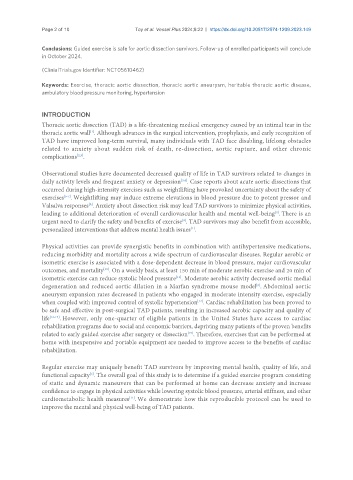Page 251 - Read Online
P. 251
Page 2 of 10 Toy et al. Vessel Plus 2024;8:22 https://dx.doi.org/10.20517/2574-1209.2023.149
Conclusions: Guided exercise is safe for aortic dissection survivors. Follow-up of enrolled participants will conclude
in October 2024.
(ClinialTrials.gov Identifier: NCT05610462)
Keywords: Exercise, thoracic aortic dissection, thoracic aortic aneurysm, heritable thoracic aortic disease,
ambulatory blood pressure monitoring, hypertension
INTRODUCTION
Thoracic aortic dissection (TAD) is a life-threatening medical emergency caused by an intimal tear in the
[1]
thoracic aortic wall . Although advances in the surgical intervention, prophylaxis, and early recognition of
TAD have improved long-term survival, many individuals with TAD face disabling, lifelong obstacles
related to anxiety about sudden risk of death, re-dissection, aortic rupture, and other chronic
complications .
[2,3]
Observational studies have documented decreased quality of life in TAD survivors related to changes in
daily activity levels and frequent anxiety or depression . Case reports about acute aortic dissections that
[3,4]
occurred during high-intensity exercises such as weightlifting have provoked uncertainty about the safety of
[5-7]
exercises . Weightlifting may induce extreme elevations in blood pressure due to potent pressor and
[8]
Valsalva responses . Anxiety about dissection risk may lead TAD survivors to minimize physical activities,
[3]
leading to additional deterioration of overall cardiovascular health and mental well-being . There is an
urgent need to clarify the safety and benefits of exercise . TAD survivors may also benefit from accessible,
[9]
[1]
personalized interventions that address mental health issues .
Physical activities can provide synergistic benefits in combination with antihypertensive medications,
reducing morbidity and mortality across a wide spectrum of cardiovascular diseases. Regular aerobic or
isometric exercise is associated with a dose-dependent decrease in blood pressure, major cardiovascular
[10]
outcomes, and mortality . On a weekly basis, at least 150 min of moderate aerobic exercise and 20 min of
isometric exercise can reduce systolic blood pressure . Moderate aerobic activity decreased aortic medial
[11]
degeneration and reduced aortic dilation in a Marfan syndrome mouse model . Abdominal aortic
[6]
aneurysm expansion rates decreased in patients who engaged in moderate intensity exercise, especially
when coupled with improved control of systolic hypertension . Cardiac rehabilitation has been proved to
[12]
be safe and effective in post-surgical TAD patients, resulting in increased aerobic capacity and quality of
life [12-14] . However, only one-quarter of eligible patients in the United States have access to cardiac
rehabilitation programs due to social and economic barriers, depriving many patients of the proven benefits
related to early guided exercise after surgery or dissection . Therefore, exercises that can be performed at
[15]
home with inexpensive and portable equipment are needed to improve access to the benefits of cardiac
rehabilitation.
Regular exercise may uniquely benefit TAD survivors by improving mental health, quality of life, and
functional capacity . The overall goal of this study is to determine if a guided exercise program consisting
[3]
of static and dynamic maneuvers that can be performed at home can decrease anxiety and increase
confidence to engage in physical activities while lowering systolic blood pressure, arterial stiffness, and other
cardiometabolic health measures . We demonstrate how this reproducible protocol can be used to
[11]
improve the mental and physical well-being of TAD patients.

